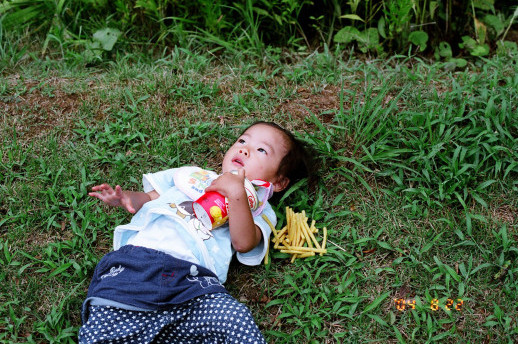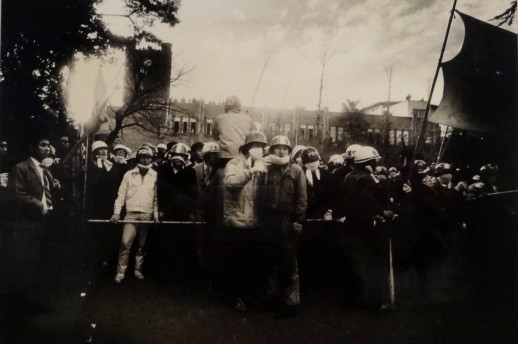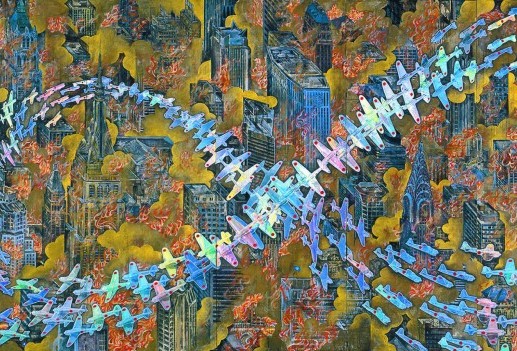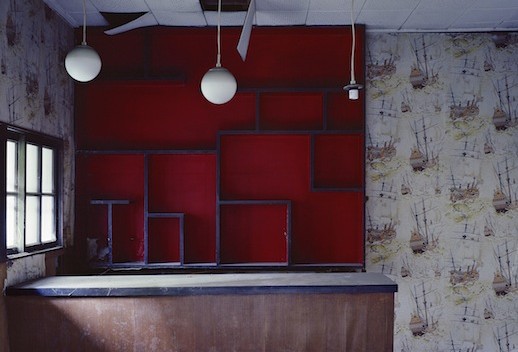Our Favorites: Exhibitions and Events in 2013
Over the past year, Tokyo Art Beat’s writers and contributors have taken in artworks in many venues across the city. Here is a short list of TABlog’s highlights from 2013.

Jennifer Pastore
One of the highlights of my art-going year was Kayo Ume’s exhibit at Tokyo Opera City. I was won over by the way Ume’s series of quirky, serendipitous, and touching snapshots of daily life add up to more than the sum of their parts. Taken on their own, pictures of a pigeon landing on a salaryman’s shoulders, school kids mugging for the camera, superheroes lined up behind the wheelchairs of the elderly, and similar scenes could be merely amusing, and Ume might be regarded as simply a photographer with a good eye and an unpretentious sense of humor. In aggregate, however, and particularly in the large-format photography at Opera City, Ume’s pictures remind us of the tenderness, joy, and surprise to be found in all of life’s bizarre, sweet, and fleeting moments. She captures not just what is remarkable in ordinary situations, but the reactions of others to them, with a particular gift for catching the emotion in the eyes of her subjects. Especially moving is her “Long Live Grandpa!” series, which shows her good-natured grandfather as he ages and sees his wife pass away. One shot features him waving proudly as he rides in a wheelbarrow, another shows him with the sleeve of his granddaughter’s kimono draped over his head, glee emanating from both of their faces. In an age when people are furiously editing their photos to make life look better than they think it seems, Ume’s photography reminds us that life is actually better than we think it is, if we only open our eyes to it.

Randy Swank
If you are a fan of photography, Tokyo usually treats you well with many interesting solo and group exhibitions year-round. The Tokyo Metropolitan Museum of Photography, in particular, offered a historical reassessment of the late 1960s, when such local photographers as Katsumi Watanabe, Koji Taki, Takuma Nakahira and Daido Moriyama began to challenge the traditional approach to photography and came up with novel answers to the seemingly simple question, “what is a photograph?” Young artists proposed a new approach to realism in photography based on a distinctly personal take on everyday life.
The ’60s and ‘70s were a particularly important period for all the arts in Japan and Shuuji Terayama was at the forefront of the avant-garde movement. Though he died young, in little more than 20 years he subverted every creative field he decided to challenge, and the retrospective exhibition organized by the Watari Museum of Contemporary Art – with which he often collaborated through the years – wonderfully presented all the different sides of his genius.
Jessica Jane-Howard
For me, 2013 has marked the settlement of new spaces here in Tokyo. Three highlights to note are the opening of the old printing and binding factory turned multi-gallery commercial art space Tolot/heuristic in Shinonome, the architecture student-come-community project suburban renovation Hagiso in Nippori, and Intermediatheque (IMT), the public museum facility situated on the second and third floor of the former Tokyo Central Post Office in Marunouchi. Each of these locales is entirely different in shape and form, but emanates a powerful atmosphere generated from the outside walls in. They are exhibition spaces charged with an energy that enters into a dialogue with the works that come to inhabit them.
Aside from these inspiring spots, this year’s Toyko Art Book Fair had an impressive turnout with an array of expertly collected publications. Luxurious stab-bound volumes nestled up beside handmade zines, badges and fan-inspired goods on tables spilling over two floors.
And finally, the show to close 2013 would have to be Akari Uragami’s solo exhibition “Exhibition Epidemico,” currently being held in the hidden away Dorothy Vacance gallery space in Omori. An overwhelmingly tactile exhibition that transforms the room into an incandescent cavern, it is the sea of colour washing over the hand-dyed textile works that makes you forget just moments before entering your extremities were painfully numb from cold.

Justin Egli
For me, the highlight of 2013 actually started at the end of 2012 and ran until February of this year, with Aida Makoto’s mind-blowing “Monument for Nothing” retrospective at the Mori Art Museum. It was an exhibition that utilised the Mori’s space to its full potential, offering up an inspiring and disturbing array of work from one of Japan’s most talented contemporary artists. A few months later, the National Museum of Modern Art treated us to the first large-scale exhibition of Francis Bacon’s work in Asia since his death in 1992. His abstract images of psychological and physical brutality still have the power to unsettle today – achieving on canvass what David Lynch achieves on film or what Beckett did on paper. Other notable highlights for me included a rare chance to see on of my favourite artists Manabu Ikeda’s work up close at “Artist File 2013”, as well as the interactive all-ages “Design Ah!” exhibition at 21_21 Design Sight. Last but certainly not least, November saw the welcome return of Trans Arts Tokyo – proving that the underground art scene is still alive and screaming in the city.
Paul Baron
1. Aida Makoto “Monument for Nothing” at the Mori Art Museum : I found his 1999 work on war propaganda sadly still relevant. Loved the huge installations and cardboard temples.
2. Kayo Ume “UMEKAYO” at Tokyo Opera City Art Gallery : A huge open book on her photography. Great expo design. Loved the thematic rooms.
3. “Artist File 2013” at the National Art Centre Tokyo : By far the best event I saw in the beginning of 2013, despite the uninspiring promotion. Huge rooms for great installations. Leiko Shiga was, and still is, a must-see!
Paul Heaton
The Open Space collection at the ICC in Shinjuku is something I always find myself coming back to. You can always find engaging, experimental work there which blurs the boundaries between technology and art. From this years’ collection, Till Nowak’s fantastical amusement park attractions in Experience of Fliehkraft(2011) left a lasting impression. And I’ll certainly be watching out for Ei Wada in 2014, whose work I saw for the first time at the ICC this year. His installation, Toki Ori Ori Nasu ver.2: Falling Records (2013), is one in an ongoing series of audiovisual works, that manage to both amplify and animate reel tape recorders to incredible effect.

Emily Wakeling
I’ve been following Tomoko Yoneda‘s photography for a while now and I was very pleased to see her mid-career retrospective at the Tokyo Metropolitan Museum of Photography. It brought together some of her most thought-provoking images and all kinds of questions about representing history. The street artist, JR, held one of the most popular ever exhibitions at the Watari Museum of Contemporary Art. His crowd-pleasing work, including the use of a special photo studio for all visitors, also utilised the power of public space to draw Tokyo’s gaze to the faces of Fukushima. Last, this year’s Roppongi Crossing was an important cross-historical, transnational scope of the contemporary Japanese art scene. While Mori is known for drawing crowds, I appreciated this exhibition’s inclusion of some rather challenging works with great political and or emotional impact.
Tokyo Art Beat thanks all its readers for their support in 2013 and wishes everyone a safe and happy new year.
Emily Wakeling
Emily Wakeling


